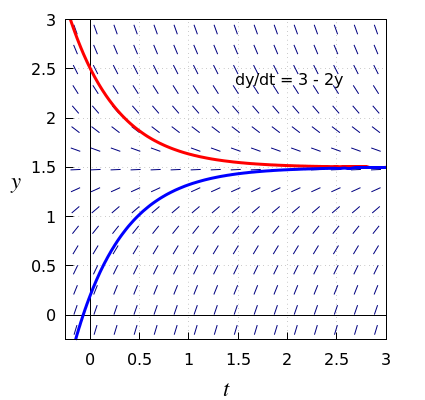Limited exponential growth: Limited exponential growth functions
 The differential equation of limited exponential growth
The differential equation of limited exponential growth
In the introduction we have already seen the differential equation of limited exponential growth and we have solved the differential equation in two different contexts.
The general solution of the differential equation \[\frac{dy}{dt}=r\cdot(a-y)\] with constants \(a>0,\;r>0\) is \[y(t)=a-c\cdot e^{-r\cdot t}\] for some constant \(c\).
\[\begin{aligned} y(t)&=15-1\cdot e^{0.25}\cdot e^{-0.25t}\\ &\approx 15-1.28\cdot e^{-0.25t}\end{aligned}\]
Asymptotics and stability Although we can solve this differential equation in explicit form, yet it is interesting to look at how the differential equation itself to get a lot of information about the possible solutions is.
For example, to know whether equilibria solutions exist and what they are, you can solve the equation\(\frac{dy}{dt}=0\) because the variable \(y\) does not change when the derivative is equal to 0. We speak of an equilibrium. In this case \(y(t)=a\) is the only equilibrium solution. If the quantity \(y\) at a certain time assumes a value smaller than \(a\), then the derivative is greater than zero and the solution curve increases at that moment. If the quantity \(y\) at a certain time assumes a value greater than \(a\), then the derivative is less than zero, and the solution curve decreases at that moment. So at small deviations from the equilibrium the solution gradually returns to equilibrium. We say that the equilibrium is attracting.
Behaviour of solutions displayed in a slope field To know how solutions of the differential equation behave near the equilibrium solution, you can also study the slope field. As a concrete example below is the slope field of the differential equation \[\frac{dy}{dt}=3-2y\] drawn together with two solution curves. The curves are constructed by following the line segments of the slope field in small time increments. In this case we have an attractive equilibrium: any solution curve near the equilibrium approaches the equilibrium. In this example an even stronger result holds: any solution approaches in the long run the equilibrium solution. Without knowing the solution explicitly, it is already possible to predict from the slope field how solutions will behave.



